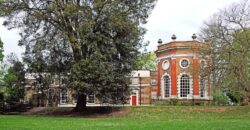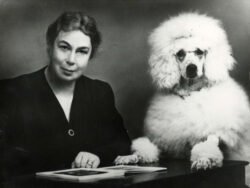Date/Time
Date(s) - Monday 11 January 2021
8:00 pm - 9:00 pm
Categories No Categories
Our 2021 talks programme got off to a great start on Monday 11 January when Minna Andersen spoke about Nellie Ionides and Orleans House. Her talk, held via Zoom, had 78 participants – and all but two of them were still logged in when she finished speaking almost an hour later, a testimony to Minna’s enthusiasm and her ability to hold an audience throughout.

Octagon Room and service wing of Orleans House, Twickenham, now the Octagon House Gallery. Jim Linwood/ Wikimedia Commons
Orleans House was a home and meeting place for royalty, politicians and gentry in the two centuries that it stood on the Twickenham riverside. The borough was deprived of one of its most historic buildings when the house was demolished in 1926. Without the foresight of local resident The Hon. Nellie Ionides, reputed to be the richest woman in England in the 1950s, it is likely that the glorious Octagon Room would have suffered the same fate.
Minna spoke about Nellie’s life, her love of art and dogs, and her legacy to what is now the London Borough of Richmond upon Thames.
Minna Andersen is a London Blue Badge Tourist Guide. Over the past 30 years, she has worked with embassies, government bodies, industry VIPs and heads of state, assisting their visits to London and offering them tailor-made experiences to explore London. These have ranged from art gallery tours and visits to famous London sights to specialist walking tours. Minna frequently appears in Finnish TV and news to promote all aspects of London. She is a volunteer with Orleans House Gallery and the Poppy Factory, using her skills as a speaker and as a guide to bring their history to life again.
John Foley reports on Minna Andersen’s talk
It’s one of the most treasured local architectural survivors. The baroque tower-like Octagon Room of Orleans House, designed and built in 1720 by the Georgian architect James Gibbs, today forms the centrepiece of the flourishing riverside Orleans House Gallery. But the old rambling Orleans House, formerly next to it, is long gone. Why then has this survived into our day?
Enter into the story one of the most remarkable women ever to have lived in Twickenham, Nellie Ionides, of a very wealthy and cultured Jewish family. Nellie’s grandfather, Marcus Samuel, had launched his family fortunes by starting a business involving the sale of exotic Eastern oriental seashells and trinket boxes to wealthy Victorians. Nellie’s father (also named Marcus Samuel, and later to become Viscount Bearsted) and her uncle Samuel Samuel developed the connection with the east, expanding their business by trading in oil. Nellie’s father had built the first oil tanker, which Nellie watched being launched in 1892 at Hartlepool. The business prospered and eventually formed part of Royal Dutch Shell.
Nellie’s life prospered too, and in 1902 she married her first husband Walter Levy in a society wedding at Mansion House (in the year that her father served as Lord Mayor of London). Walter Levy died in 1923 from severe wounds suffered in the First World War. Nellie meanwhile became a collector of porcelain and her artistic and cultural passion brought her into contact with Basil Ionides, grandson of a Greek ambassador to London. His family were wealthy and cultured too, and knew socially some of the pre-Raphaelite circle, Edward Burne-Jones, Rex Whistler and William Morris. Indeed, Ionides himself was an accomplished writer on art, when not employed in his profession as an interior designer. In such professional capacity one of his many achievements was the interior design of the Savoy Hotel, including a sculpted black cat called Casper, curled up and dressed in a white napkin, who would be placed in the empty seat of any party numbering thirteen (13 being deemed by the Savoy staff to be deeply unlucky). And Casper is still at work today!
Nellie and Basil Ionides were married in 1930. The newly-weds now acquired and renovated Buxted Park in Sussex, where they entertained lavishly – their guests included King George V and Queen Mary, a great friend of Nellie, and Winston Churchill. When the 1939 war came Basil and Nellie were saddened by the damage caused to many historic houses, often scavenging ruins to rescue architectural items of historic value.
But what about Orleans House? Nellie was already no stranger to Twickenham, having acquired Riverside House in the 1920s. She was horrified to learn that neighbouring Orleans House and its adjoining Octagon Room, by then dilapidated, were on the point of being sold to industrial gravel developers. With her acute aesthetic and historic sense, she would have known that the Octagon Room had been built two hundred years before in baroque style for entertainment and dining purposes, the original owner James Johnstone, a cultured statesman, being acquainted with members of the German Protestant Hanoverian royal family, who of course in 1714 became our monarchs following the death of Queen Anne without legitimate Protestant successors.
She would have known too of the huge exotic dinner parties to which in 1729 Queen Caroline, wife of George II, brought her own cooks to help serve up to 25 courses, the feast lasting hours, the table groaning with ostentatious expensive crockery and cutlery, and boasting as a centrepiece the latest fashionable exotic discovery – a pineapple!
And Nellie would have known of the period from the late 1790s when Orleans House acquired the name by which it is known today. Louis Phillipe, Duke of Orleans (later King of the French 1830 to 1848) took refuge in Twickenham during the French Revolution, lived here for several stretches of time and fell in love with “peaceful old Twick”. He returned in 1844 to host a visit by the young Queen Victoria (there is a photograph), who was impressed, thinking the house “very pretty”. Later his son, the Duc d’Aumale, also followed his father into exile in 1850, again living here and bringing his vast library and important art collection (now preserved in Paris). Both father (friendly with the owner of the Crown pub) and son (president of the rowing club) mixed with the locals.
And so yes, in 1927 just in time, Nellie herself bought the Octagonal Room, thus saving it, and the view from Richmond hill, from the gravel developers. When she died in 1962 this building, and her huge collection of paintings were donated to the then Borough of Twickenham, and survive today in the custody of the London Borough of Richmond upon Thames. She had also amassed a huge quantity of porcelain (the envy of her friend Queen Mary).
There was time left for only a brief mention of Nellie’s love of dogs and poodles and her family ”cottage industry” of weaving poodle wool into material to make suits.
Minna’s triumphant presentation was a suitably glittering tribute to a remarkable woman!

